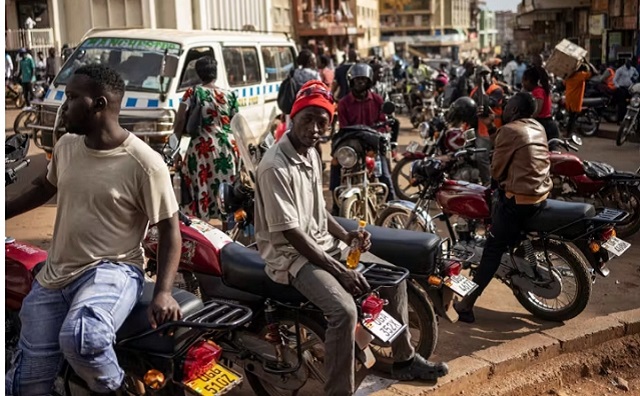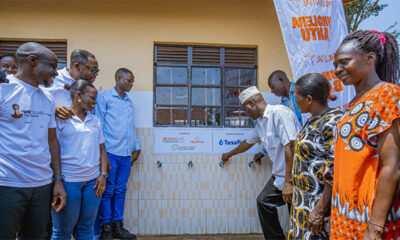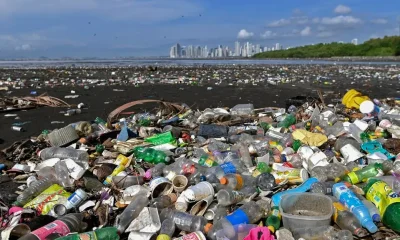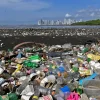Climate Change
Uganda Grapples with the Deadly Cost of Air Pollution
At sunrise in Kampala, as charcoal fires light and boda bodas hit the road, the air begins to thicken with a deadly mix of dust, smoke, and exhaust. Few notice, but everyone breathes it in. Air pollution, once ignored, now stalks the lungs of millions and threatens the nation’s future.
Between 2018 and 2021, air pollution was responsible for an estimated 7,200 deaths in Kampala alone, accounting for one in every five fatalities, according to data from the Kampala Capital City Authority (KCCA).
“You can’t buy a plot of clean air,” warned Jennifer Musisi, former Executive Director of KCCA. “But you can buy a bottle of clean water.” Her words, once a metaphor, now ring with the urgency of a national emergency.
As a public health emergency, air pollution in Uganda originates from multiple sources: biomass burning for cooking, unregulated vehicular emissions, industrial activities, and rampant open waste burning, often involving plastics.
“Many people think burning trash is harmless,” said Dr. Alex Ndyabakira, Director of Public Health and Environment at KCCA. “But when plastics and synthetic materials are incinerated in open spaces, the toxins released can linger in the air for hours, even days.”
In response, the government launched a clean air action plan in 2022 following years of baseline studies. That plan expired in June 2025 and is now under review. “Everyone at KCCA is committed,” Dr. Ndyabakira emphasized. “But we need stronger coordination, consistent implementation, and more public awareness.”
He cited transport as a major contributor to poor air quality. “Out of Kampala’s 2,100km road network, only 600km are paved,” he said. “With just 30 percent of roads tarmacked, the dust generated from the rest, combined with emissions from aging vehicles and open burning, significantly degrades our air.”
Kampala’s air pollution levels are grim. According to the World Health Organization (WHO), the city’s ambient air pollution exceeds safe limits by up to 12 times. The Real Urban Emissions (TRUE) Initiative, in collaboration with the United Nations Environment Programme (UNEP), conducted Africa’s first real-world vehicle emissions tests in Kampala between July 3 and 29, 2024.
Out of the 6,000 vehicles tested, most exceeded Euro 4 emission limits—regardless of their age or origin. “The average minibus taxi is 25 years old, with some emitting six times more black carbon than those under 15 years,” the TRUE report noted.
These emissions, particularly the fine particles known as particulate matter (PM2.5), are directly linked to respiratory illnesses, stroke, cancer, and heart disease.
As of July 2024, Uganda had approximately 2.3 million registered motor vehicles, including private cars, motorcycles, public transport vehicles, and commercial trucks, according to the Ministry of Works and Transport and the Uganda Revenue Authority.
But Dr. Ndyabakira cautions against focusing solely on the growing number of vehicles, warning that other significant sources of pollution risk are being overlooked. “We’re conducting a source apportionment study to understand how much pollution comes from waste burning, vehicles, and industry. We must stop guessing and start measuring.”
Despite a solid regulatory framework, enforcement remains weak. “It is an offence under the Air Quality Regulations to burn waste,” said Jennifer Kutesakwe, a Senior Environmental Inspector at the National Environment Management Authority (NEMA). “Yet it’s a daily reality.”
NEMA is working with KCCA and Makerere University’s AirQo research project to support air quality management. With 176 air quality monitors deployed nationwide, hotspots are now identifiable. “The problem is no longer lack of knowledge, it’s lack of action,” Kutesakwe added.
Recent data from AirQo shows that between October and December 2024, Uganda’s average PM2.5 concentration was 33.39 μg/m³ (micrograms per cubic meter), more than double the WHO’s recommended daily limit of 15 μg/m³.
Soroti had the worst readings at 46 μg/m³, followed by Masaka and Mityana. Even in cleaner areas like Mbarara (20.7 μg/m³), air quality remained unsafe. In Northern Uganda, Gulu recorded 12 μg/m³ at Mary Queen of Peace, while Lira’s Mukwano Road spiked to a hazardous 73 μg/m³.
Uganda has adopted Euro 4 vehicle emissions standards and plans to transition to Euro 6 by 2030. But implementation is lagging.
“The government has now fully taken over the Société Générale de Surveillance (SGS) vehicle inspection, verification, testing, and certification services stations,” said Eng. Immaculate Nyamaizi, Senior Inspector at the Ministry of Works and Transport. “We are working on a mandatory inspection rollout. But we need more staff, better funding, and political will.”
In Uganda, SGS has played a significant role in the country’s Pre-Export Verification of Conformity (PVoC) program, ensuring imported products meet the required standards. “In Uganda, for a project to succeed, you must align it with the prevailing political climate. That’s the reality,” she added.
UNEP’s Rob de Jong was more direct: “Effective regulation of both vehicle and fuel standards is not optional anymore. The data is indisputable; we must act.”
Voices From the Ground
Despite the rising threat, public awareness remains dangerously low. In Kampala’s Kisenyi neighborhood, vendors burn rubbish behind stalls, unaware of the carcinogenic chemicals in the air.
“I know smoke is bad,” said David Kasujja, a boda boda rider, “but what choice do we have? Garbage isn’t collected.”
Others, like Kalerwe market food vendor Sumin Nabachwa, prefer cooking with firewood. “It keeps the traditional flavor of our food. Gas is for the rich,” she said.
In Kamwokya, Fred Kayanda echoed similar concerns. “Rentals don’t have garbage pits. Paying for garbage collection is too expensive. Burning is the only way.”
“Such realities reflect a larger contradiction,” said Dr. Ruth Nankabirwa Ssentamu, Minister of Energy and Mineral Development. “People want change but lack alternatives. Without investments in waste management and public education, harmful habits will continue.”
Sheila Watson at the Fédération Internationale de l’Automobile (FIA) Foundation, an independent UK charity focused on promoting “Safe, Clean, Fair, and Green” mobility, warned: “We have the tools and the knowledge. What we need is the courage to act. We cannot pass the toxic legacy of poor urban policy to the next generation.”
Signs of Hope
Uganda’s clean energy efforts, including its e-mobility strategy and transition to clean cooking fuels, offer a glimmer of hope. Eng. Irene Pauline Bateebe, Permanent Secretary at the Ministry of Energy, affirmed: “Clean energy, sustainable transport, and vehicle inspection are pillars of our broader National Development Plan IV. We’re not just talking about it; we’re embedding it into national strategy as we aim to achieve universal access to power by 20240.”
Mallery Crowe, a researcher and lead author of the TRUE report at the International Council on Clean Transportation (ICCT), a global nonprofit public policy think-tank, said the Kampala study offers policymakers a roadmap. “Remote sensing has given us unprecedented insights. Now it’s time to translate them into action.”
If Uganda fails to act, air pollution threatens to reverse decades of health and development progress. But if science, policy, and public will align, a cleaner, healthier future is within reach.
Why Clean Air Matters
Clean air is fundamental to life. Yet millions across Africa inhale air filled with invisible toxins. According to the Clean Air Fund and Health Policy Watch, air pollution kills 1.1 million people annually in Africa. In East Africa, it was the second leading cause of death in 2021, contributing to 294,000 fatalities. Fine particulate matter (PM2.5) can penetrate deep into the lungs and bloodstream, increasing the risk of cardiovascular diseases, cancer, respiratory infections, and neurological disorders. Children, the elderly, and people with pre-existing health conditions are most vulnerable.
Beyond human health, air pollution contributes significantly to climate change and food insecurity. Black carbon, for instance, has one of the highest global warming potentials and damages crops and ecosystems.
Five African countries: Niger, Nigeria, Egypt, Mauritania, and Cameroon—rank among the world’s ten most polluted, with PM2.5 levels as high as 80 μg/m³.
If no action is taken, pollution-related costs in African cities are projected to rise by 600% by 2040. But switching to clean energy could save 120,000 lives, cut emissions by 20%, and unlock $20 billion (approx. UGX 76 trillion) in economic growth in just four cities—Lagos, Cairo, Johannesburg, and Accra.
What Must Be Done
To effectively combat air pollution, Uganda must transition to clean energy and sustainable transport by embracing electric and non-motorized mobility, expanding public transportation networks, and promoting clean cooking alternatives to reduce indoor emissions. At the same time, it is essential to strengthen and rigorously enforce emission standards for vehicles and industries through mandatory inspections.
Investments in real-time air quality monitoring are critical to guide evidence-based policymaking, while greening urban spaces through tree planting can help naturally filter pollutants and cool cities.
Equally important is community empowerment, raising public awareness, encouraging behavioural change, promoting responsible waste disposal, and fostering citizen engagement in environmental protection.
Air pollution is a silent killer, but it is also a solvable one. By making clean air a national priority, investing in sustainable solutions, and holding polluters accountable, Uganda can reclaim the basic human right to breathe safely.
As Jennifer Musisi rightly said, “You can’t buy a plot of clean air.” But with political will, public commitment, and collective action, Uganda can protect the breath of its people and build a healthier, more resilient future, one in which no one has to fight for the right to breathe.
Source; URN
Comments



























